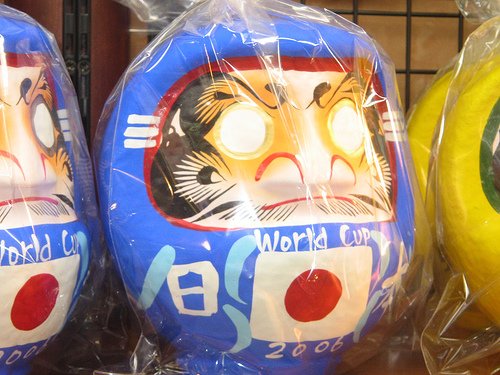When you learn a language as different from English as Japanese is, some things are going to be challenging, such as the tendency for Japanese to leave the subject off a sentence, and sometimes the object and predicate, since they’d just get in the way. There are grammatical markers that define the subject, object, preposition and other parts of sentences, which helped me to “parse” the grammar of Japanese in an almost XML-like fashion (not that I knew what XML was back in 1987). Another unique area of learning Japanese are the “counters,” the words you use when counting different objects based on their shape. If you’re counting flat objects like sheets of paper, you use mai (ichi mai, ni mai, san mai, 一枚、二枚、三枚). For any long, cylindrical object, you use hon (ippon, ni hon, san bon、一本、二本、三本). (Roppingi, if you want to know, means “six trees” — roku plus the hon/pon counter, and ki is Japanese for tree.) There are some difficult ones to get down — for example, an umbrella is counted with hon/pon because it’s long and cylindrical when closed, but when it’s opened, it’s in a different shape. How do you count it? Does a comatose body or freshly-killed corpse get counted with the same counter as the one for people? Incidentally, the counter for pairs of chopsticks is zen (no, not that zen, a totally different one, 膳 not 禅), which works out to be ichi zen, ni zen, san zen. Since knowing the proper way of counting pairs of chopsticks is somewhat archaic, I’ve always found that Japanese are shocked when a foreigner knows how to do it correctly. If you want to impress someone from Japan, pull this out on them and watch the surprise on their face.
You’ve been in Japan too long when, while driving by a new building with a sign that says GOD HAIR & MAKE, you know exactly what kind of establishment it is (a hair dresser that also does make-up). All languages have jokes or puns “hard wired” into them that are unique to that language — I’m sure the famous “Who’s on First?” comedy routine by Abbott and Costello could only work in English. The word kami can have three meanings (with appropriately differentiated kanji, of course), God, hair and paper (神, 髪 and 紙), which gives rise to little puns about God’s Hair and the like. Another (bad) joke is related to counting words, above. The word for ribs is rokkotsu (roh-KOTSU、肋骨), which sounds to the ear like a counting word for “six bones” (六骨), so if you pretend to count someone’s ribs and stop at six, it can be funny. Iruka means dolphin, but also “does [it] exist?” which causes learners of the language to make jokes like Iruka iruka? (Are there any dolphins?). Similarly, ikura refers to the salmon roe that tastes so good on sushi, but also “how much is this?” leading to Ikura ikura? (How much is the salmon roe?). Finally, rakuda means “camel” but also “it is comfortable,” which means you can be sure to see TV commercials with camels relaxing while selling you some product. There, now you know some useless Japanese jokes.
Japan is certainly the land of the “boom,” and when something starts to get popular, you’d better watch out because it can really take off. The newest trend this summer is supposedly megane dansei, (眼鏡男性) or “men with glasses,” a wave of men going out of their way to wear attractive-looking glasses for the sharp, intelligent style it gives them. In the past, Japan has gone through several “glasses booms,” generally centered around women, which saw stylish Tokyo females sporting the most bizarre-looking horn-rim Librarian-esque eyewear you can imagine, just because it had become fashionable. The Summer of 2006 may be time for men to take their turn in the center of svelte glasses fashion in Japan. Over the past 15 years I’ve often observed that men seem to be moving in on the territory traditionally occupied by women, with the rise of marketing of make-up and hair care products to men and magazines that appeal to the slightly effeminate, yaoi-esque side of males. I wonder if the summer’s men-in-glasses boom is part of this larger trend?
Among the many hard-to-find Japanese products that J-List brings to you are the DVD releases of Yulia Nova, the fabulous Russian model who was discovered by Japanese photographer Satoshi Kizu. She’s hugely popular here in Japan and all throughout the Internet, one of the most incredibly (and all-natural) models of the past generation. We’re happy to announce three new Yulia Nova DVDs will be released soon, the dynamite Yulia & Friends series, which feature all-new footage of Yulia and other popular models appearing together. The region-free DVDs are completely mosaic-free as well. They new Yulia releases will be out in August, so preorder your copies now!
















